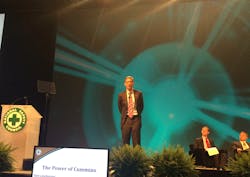NSC 2014: Leadership Engagement Drives EHS Success at Cummins
Over the past decade, engine maker Cummins Inc. has embarked on an EHS journey that’s been “nothing short of amazing,” Chairman and CEO Tom Linebarger said during an executive forum at the National Safety Council’s 2014 Congress and Expo in San Diego.
But Cummins, which received the National Safety Council’s 2014 Robert W. Campbell Award for EHS excellence, isn’t even “partway” to the finish line – at least in the eyes of its leaders.
“All of us feel like we have way more to do to make sure that our environment is as safe as it could be, that our sustainability footprint is as good as it can be and that we continue to set more aggressive goals every year,” Linebarger said. “That’s just how we think about it.”
National Safety Council CEO Deborah Hersman lauded Cummins for being “a true learning organization." Linebarger attributed that to the company’s “relentless” focus on continuous improvement.
“It’s relentless, and by the way, it’s tiresome,” Linebarger said. “If you think you finally have something solved, somebody else is going to explain to you why there’s more to do. That relentless energy finds its way into safety, environmental and health. We never feel like we’re done.”
The company’s approach to EHS starts with leadership engagement. Linebarger, who began his career at Cummins assembling diesel engines for Dodge Ram pickups, receives reports on every major incident within 24 hours of their occurrence – per company policy.
Every leader has to be outspoken, has to be out front about safety, and there’s no need to do any economic calculus – just get going.— Cummins CEO Tom Linebarger
But Linebarger emphasized that “every manager needs to feel accountable” for safety. To that end, the company launched a program called “Live It, Lead It” to ensure that “every leader understands their role in safety.” As part of the program, more than 2,500 Cummins leaders have attended summits in which they create safety plans to implement in their departments.
To show how the program changes the way that company leaders think about safety, Linebarger shared an experience from his visit to a Cummins plant in Juarez, Mexico. Just as the plant manager was about to take Linebarger on a tour of the facility, he asked the CEO to place his hands on the safety rails, noting that a worker recently had tripped and fallen on the stairs, ending a streak of 400 days without an accident.
“This is exactly the living-leader behavior that we’re looking for – a manager willing to tell their boss’s boss’s boss to put their darn hand on the safety rail,” Linebarger said. “By the way, I always put my hand on the safety rail now, which is exactly what we should be doing.”
The use of job-safety analyses is another key safety initiative at Cummins. While the use of JSAs is common at many companies, it’s been a sea change for the engine maker’s thousands of service technicians, who are accustomed to getting the job done regardless of the working conditions at customer sites.
“We want our service technicians to look at the risks of each job before they do it, analyze the risks and figure out how they’re going to manage them,” Linebarger said. “We still want them to do be responsive, but we want them to make sure they’re looking at the risks.”
As an example, Linebarger told the story of a Cummins technician who responded to a service call to repair an engine on a ship. The service technician assessed the situation and concluded that it was “a very, very unsafe environment,” and refused to perform the repair until the customer abated the hazards.
“This is exactly the behavior we’re looking for,” Linebarger said.
The company’s emphasis on safety leadership is embedded in one of its mission statements, which “says that we demand that everything we do leads to a cleaner, safer and healthier environment.”
“When we wrote this more than 10 years ago, we used the word ‘demand’ on purpose,” Linebarger said. “It took some debate among our leadership team, but we settled on ‘demand’ because we wanted to eliminate the economic calculus, [the debate] about what’s the ROI on this. We decided that we’re done talking about it. It means that every leader has to be outspoken, has to be out front about safety, and there’s no need to do any economic calculus – just get going.”
